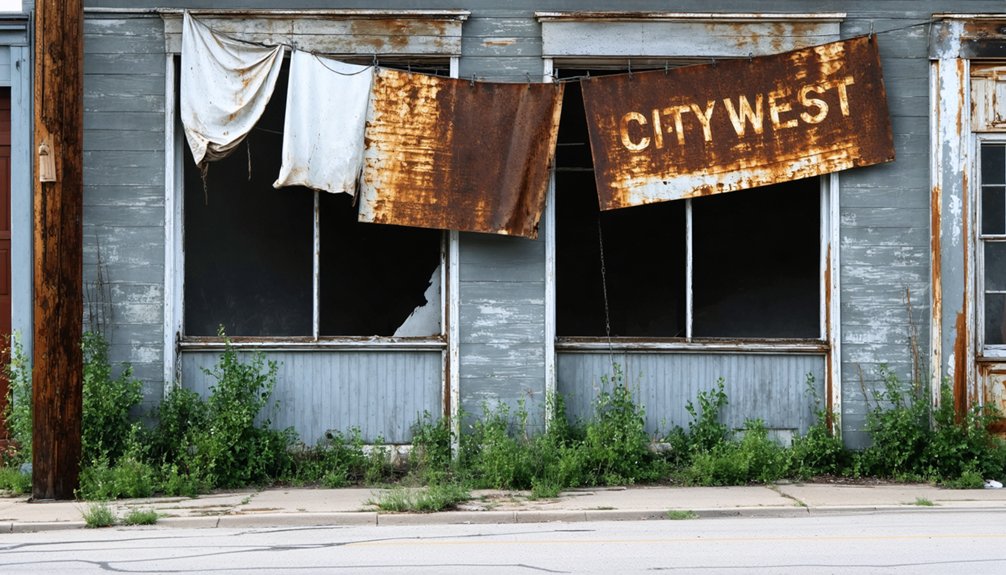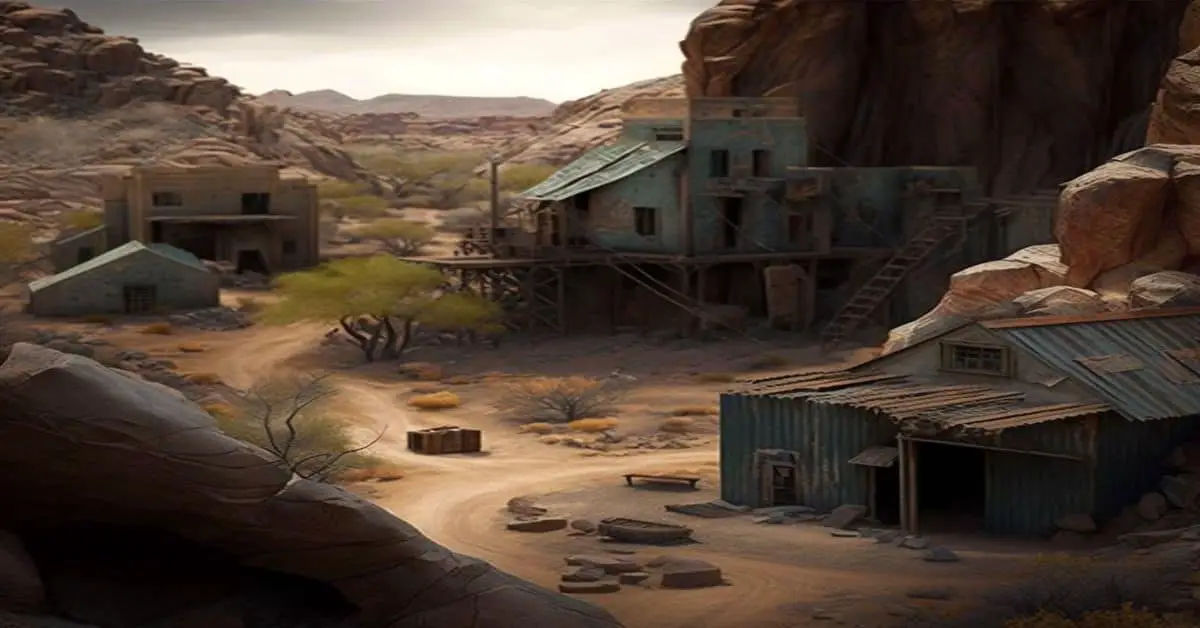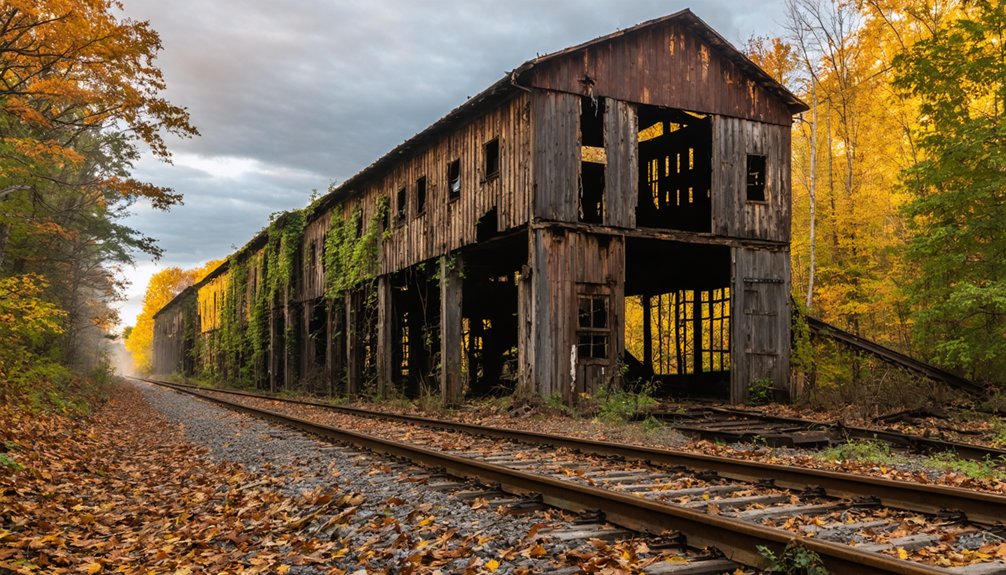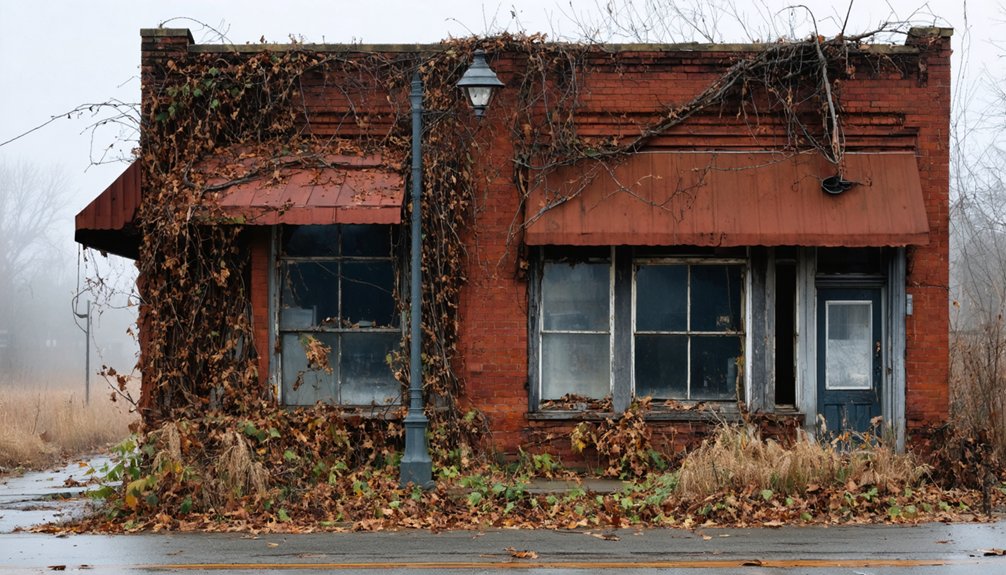You’ll find City West’s ghost town remains within Indiana Dunes State Park, where ambitious founders established a rival to Chicago in 1836. The settlement boasted a 22-room hotel, 650-foot pier, and housed 200 residents across 40 buildings. The Panic of 1837 triggered its rapid decline, and by 1854, a devastating wildfire erased most traces. Today, archaeological evidence reveals the settlement’s original 25-block grid plan, hinting at untold stories beneath the dunes.
Key Takeaways
- City West was an ambitious 1836 settlement near present-day Indiana Dunes State Park that aimed to rival Chicago’s port dominance.
- The town peaked with 40 buildings, including a 22-room hotel, and housed approximately 200 residents before its rapid decline.
- Economic collapse during the Panic of 1837 devastated City West’s development, causing property values to plummet dramatically.
- A devastating forest fire in the 1850s destroyed the remaining structures, marking the final demise of this failed lakefront settlement.
- Archaeological evidence reveals a planned 25-block grid system, with remnants now preserved within Indiana Dunes State Park.
The Birth of an Ambitious Lake Michigan Settlement
As speculators sought promising locations along Lake Michigan’s southern shore in the 1830s, four ambitious entrepreneurs established City West in 1836 near the historic Petit Fort site.
Jacob Bigelow, William Morse, Jacob Hobart, and Leverett Bradley chose this strategic location at Fort Creek’s mouth, just 10 miles west of Michigan City, to pursue their settlement aspirations.
Engineers claimed the deeper waters at Fort Creek would provide superior harbor capabilities.
Facing founding challenges from their rival Michigan City, they forged ahead with their vision of creating a bustling port town.
By mid-1837, they’d recorded the official plat after careful surveying work.
You’ll find their choice of location was no accident – they’d positioned City West perfectly to capitalize on planned regional transportation networks, including ambitious railroad projects that would connect Lake Erie to the Mississippi River via Lake Michigan.
Like Berlin’s City West development in 1895, the founders envisioned their settlement becoming a thriving commercial center.
Dreams of Rivaling Chicago’s Success
If you’d lived in the bustling frontier of 1837, you’d have witnessed City West‘s bold bid to outshine Chicago through its ambitious ninety-block development plan and proposed deep-water harbor at Fort Creek.
You’d have seen investors pour money into the settlement’s grand vision, bolstered by Senator Daniel Webster’s visit and apparent endorsement of the “grand city on the lake.”
Yet by 1840, as Chicago’s population surged to 4,500 while City West crumbled under financial panic and failed federal support, you’d have watched this dream of mercantile supremacy fade into abandonment. Under the leadership of Jacob S. Bigelow, the Michigan City & Kankakee Railroad Company president, the town was officially platted as the first in Porter County on July 14, 1837.
The settlement’s decline represents one of several dream cities of Calumet that failed to materialize despite their ambitious visions for rivaling Chicago’s dominance.
Big Plans, Bold Vision
While Chicago was still a small village in the 1830s, ambitious developers envisioned City West as its future rival on Lake Michigan’s southern shore.
Similar to Chicago’s planned development timeline, the city aims for completion by 2026.
The urban planning was remarkably detailed, with visionary leadership from Jacob Bigelow, Leverett Bradley, Joshua Hobart, and William Morse mapping out ninety blocks near Fort Creek. Similar to Indianapolis’ initial city plat, they created an organized grid pattern for future growth.
You’ll find their ambitious vision reflected in:
- A strategic harbor and canal system connecting Fort Creek to the Little Calumet River
- Streets named after U.S. presidents and natural features like Elm, Oak, and Willow
- Ninety planned blocks subdivided into hundreds of lots for thousands of future residents
The developers exaggerated Fort Creek’s size to attract investors, betting on federal funding for a harbor that would transform this settlement into a major metropolis.
They invested heavily in surrounding lands, convinced their location would become a powerful economic hub.
Investor Interest Gone Wrong
Despite City West‘s promising start in 1836 with forty buildings and a 22-room hotel, the development’s ambitious dream of rivaling Chicago crumbled during the Panic of 1837. Investor motivations had initially seemed sound, with prominent figures like Jacob Bigelow and William Morse envisioning a major port city on Lake Michigan.
Today, visitors can explore the site within Indiana Dunes Park, where nature has reclaimed the once-bustling settlement.
Economic miscalculations became apparent when the financial crisis struck. Banks demanded immediate loan repayments, and the federal government withdrew promised port funding.
You can trace the town’s rapid decline through a series of devastating setbacks: speculators defaulted on loans, properties faced foreclosure, and residents fled. By 1839, City West stood largely abandoned, its grand vision of competing with Chicago shattered. The small population of 200 American families who once called the settlement home quickly dispersed.
A forest fire in the 1850s delivered the final blow, destroying what remained of this failed enterprise.
Competition Doomed From Start
From its inception in 1836, City West‘s aspirations to rival Chicago as a major Lake Michigan port city revealed a fundamental misunderstanding of geographical and economic realities.
The founders’ vision of economic rivalry fell short as they established a basic settlement near Fort Creek, lacking essential infrastructure that would’ve supported port competition.
The town’s remaining pier lasted until 1870s, marking the final remnant of this once-ambitious lakeside development.
- A modest 25-block town with only a sawmill and pier
- No schools or churches to anchor permanent residents
- Limited protection from Lake Michigan’s harsh environment
You’ll find it fascinating that while Chicago flourished with rapid development and strategic advantages, City West’s founders – Jacob Bigelow, William Morse, Jacob Hobart, and Leverett Bradley – couldn’t overcome the fundamental challenges of their location.
When the Panic of 1837 struck, their dreams of creating a competitive port city quickly unraveled, leaving behind what would become Indiana’s most ambitious ghost town.
Life in Early City West
You’d find daily life in City West centered around the town’s prominent 22-room hotel and tavern, which served as the social hub for both residents and travelers passing through the Lake Michigan port settlement.
Your typical day might involve working at the sawmill, tending to sandy soil gardens for sustenance, or conducting trade from the 650-foot wooden pier that extended into the great lake.
Whether you were one of the 200 peak residents or a visitor, you’d likely spend evenings at the frontier hotel, where community gatherings and social activities provided relief from the challenging pioneer lifestyle.
The town’s ambitious development attracted young men seeking wealth until economic troubles brought growth to an abrupt halt.
Daily Routines and Work
While City West’s brief existence lasted only a few years, the daily routines of its 200 residents centered around lumber production, shipping activities, and basic survival needs.
Your daily chores would’ve included tending to sandy-soil gardens and participating in community gatherings at the 22-room hotel and tavern – the largest establishment between Chicago and Detroit.
You’d witness:
- Workers operating the bustling sawmill, processing lumber for ongoing construction
- Ships docking at the 650-foot pier, bringing supplies and potential traders
- Children foraging for berries in the dunes while watching sailing vessels on Lake Michigan
Life wasn’t easy – you’d face harsh dune conditions and limited infrastructure, with no schools or churches to support social development.
Native Americans in canoes would occasionally visit, observing your settlement’s activities from the shoreline.
Frontier Hotel Social Life
During its brief heyday, social life in City West revolved around the impressive 22-room Frontier Hotel, also known as the Exchange House.
You’d find hotel gatherings ranging from political speeches, like U.S. Senator Daniel Webster’s 1837 Fourth of July address, to informal community bonding events where settlers shared stories and danced.
Without a church or school, the hotel served as the town’s de facto community center, post office, and meeting place for about 20 families and 200 individuals.
While harvesting dune berries or visiting the blacksmith, you’d likely stop by the hotel to catch up with neighbors.
Though the Panic of 1837 cut short City West’s dreams, the hotel remained essential until its relocation to Chesterton in the 1850s.
Lake Michigan Trading Activities
Beyond its role as a social hub, the Frontier Hotel‘s position near Lake Michigan placed it at the heart of City West‘s ambitious trading aspirations.
You’d find the town strategically positioned opposite Chicago, with plans for extensive lakefront commerce connecting regional railroads to water routes.
The bustling scene of early City West’s trading activities included:
- A 650-foot wooden pier stretching into Lake Michigan’s waters
- Designated areas for canal basins and shipping infrastructure
- Multiple retail establishments and mills supporting local commerce
You could’ve witnessed the town’s brief but vibrant trading period, where hundreds of young entrepreneurs flocked to capitalize on its prime location.
However, without federal backing for essential port facilities and the devastating impact of the 1837 financial panic, City West’s dreams of becoming a major trading center quickly unraveled.
The Financial Panic That Changed Everything
As the devastating Panic of 1837 swept across America’s frontier, City West’s ambitious dreams of becoming a thriving Lake Michigan port crumbled into dust.
The widespread economic instability, triggered by rampant land speculation and unstable banking practices, hit the fledgling town particularly hard.
Reckless financial practices and widespread speculation delivered a crushing blow to the vulnerable young settlement’s prospects for survival.
You would’ve witnessed the rapid collapse of City West’s foundation as speculative investments dried up and property values plummeted from hundreds of dollars to mere cents per acre.
Without capital to build essential infrastructure like harbors, canals, and railways, the town couldn’t compete with neighboring Michigan City, which enjoyed stronger political support and funding.
Signs of a Fading Community
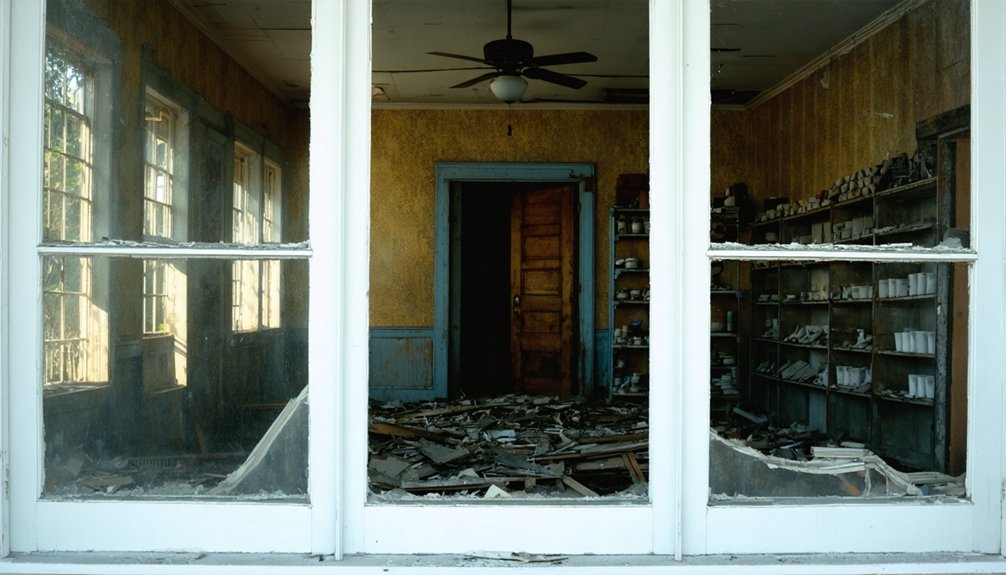
While City West’s dreams of grandeur lingered briefly in the late 1830s, the physical signs of its decline became unmistakable.
You would’ve witnessed the community’s resilience crumbling as essential public buildings vanished, leaving the settlement without schools or churches to anchor social life. The historical significance of the once-promising town faded as nature reclaimed the landscape.
The decay manifested in stark ways:
- Only a solitary 1930s bathhouse remains near the park entrance
- The grand 22-room hotel and 40 homes stood empty by 1839
- Lake Michigan’s waters gradually consumed the pier by the 1870s
After fires ravaged the remaining wooden structures in 1853, the sand dunes slowly swallowed what was left, including the cemetery – erasing nearly all traces of this ambitious settlement.
Nature Reclaims the Land
Once City West’s residents abandoned their ambitious settlement in 1839, nature swiftly began its relentless reclamation of the land.
You’d have seen empty homes quickly overtaken by native vegetation and shifting dunes, while children picked fruit from untended gardens now surrounded by wilderness.
Nature’s reclamation accelerated through ecological succession as resilient dune species colonized the sandy soil.
Wave after wave of hardy plants marched across the abandoned settlement, nature’s foot soldiers reclaiming what humans had briefly borrowed.
The humid lakeside climate hastened wooden structures’ decay, while the 1853/1854 forest fire destroyed most remaining buildings.
Lake Michigan’s changing shoreline eventually submerged the pier, and dune migration buried foundations and the cemetery beneath layers of sand.
Archaeological Discoveries and Remnants
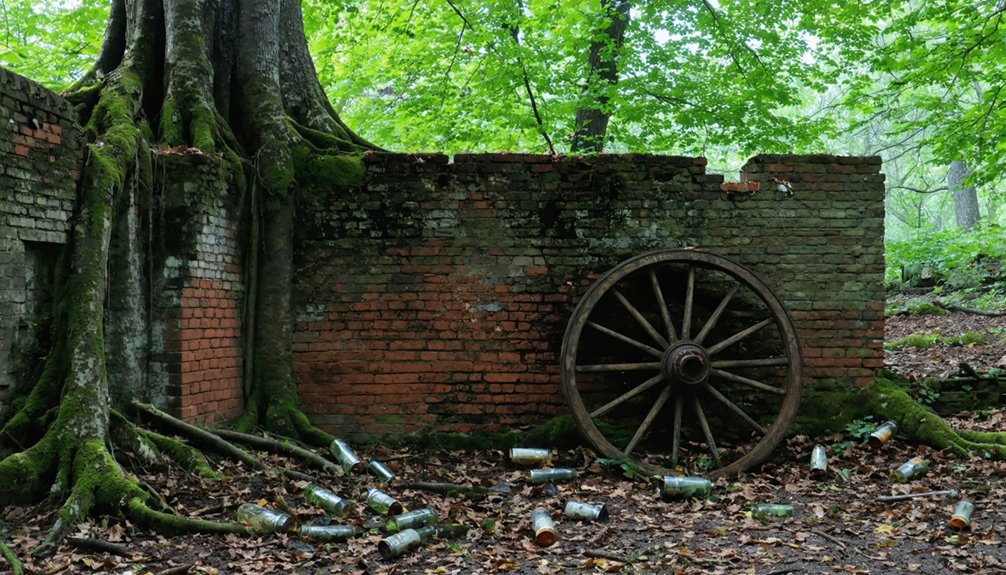
Modern archaeological investigations have revealed fascinating details about City West’s brief but ambitious existence. Using advanced archaeological techniques, researchers have mapped the settlement patterns of this forgotten town, uncovering evidence of approximately forty structures and a 650-foot wooden pier extending into Lake Michigan.
The site tells a story of rapid development and sudden abandonment through these discoveries:
- Foundation outlines reveal an ambitious 25-block grid plan, including a 22-room hotel.
- Domestic artifacts from the 1830s show evidence of daily life and commerce.
- Charred remains and burned debris layers confirm the devastating 1854 wildfire.
You can still trace the town’s footprint today, though nature has reclaimed much of the site. Sand dunes have partially buried the cemetery, while storms and time have obscured many of the original features.
Modern-Day State Park Preservation
Since its establishment in 1926, Indiana Dunes State Park has preserved the former City West site within its 2,000-acre expanse, transforming the ghost town’s footprint into a protected natural sanctuary.
You’ll find no modern infrastructure on the original town site – nature has completely reclaimed it, with only the City West Shelter serving as a subtle reminder of its history.
Park conservation efforts focus on maintaining ecological balance through active dune stabilization, invasive species control, and native planting programs.
While you can explore the area through hiking trails, you won’t find detailed historical exhibits or reconstructed structures.
Instead, the park emphasizes natural preservation over historical presentation, protecting the landscape from urban development while managing it primarily for recreation and ecological education.
Frequently Asked Questions
Were Any Famous Pioneers or Historical Figures Associated With City West?
You won’t find many pioneer stories or historical landmarks tied to famous figures here, except for Senator Daniel Webster’s brief 1837 visit to deliver a speech to local Whigs.
What Happened to the Original Residents After Leaving City West?
You’ll find original residents scattered to neighboring towns seeking new opportunities, with some forming New City West (Tremont). Many pursued livelihoods in Indiana’s industrial and agricultural regions after the 1837 crash.
Did Any Businesses From City West Relocate to Other Nearby Towns?
Like scattered seeds that never took root, you won’t find evidence of any business relocation from City West. Records show the local economy collapsed, with businesses simply shutting down rather than moving elsewhere.
Were There Any Documented Native American Settlements in the Area Before?
You’ll find that Potawatomi and Miami Native tribes established settlements in the area, following settlement patterns along Lake Michigan’s shoreline and inland waterways before City West’s development.
How Many Shipwrecks Occurred Near City West’s Pier During Its Existence?
You won’t find a precise shipwreck frequency for City West’s pier itself, though maritime history records show two major wrecks nearby – the Muskegon and J.D. Marshall sank in 1910-1911.
References
- https://www.islands.com/1754423/city-west-ghost-town-abandoned-buildings-once-dreamy-town-indiana-coastal-eerie-dune-beach/
- https://www.atlasobscura.com/places/city-west-ghost-town
- https://en.wikipedia.org/wiki/City_West
- http://www.gribblenation.org/2019/05/ghost-town-tuesday-ghost-towns-of.html
- https://stephenjessetaylor.wordpress.com/2013/07/27/city-west-lost-metropolis-of-the-indiana-dunes/
- https://gregandbirds.wordpress.com/2017/11/21/lost-to-nature-1-city-west-and-tremont-indiana/
- http://www.porterhistory.org/2017/01/lost-porter-county-city-west.html
- https://www.youtube.com/watch?v=Lf2AQ6YfwxE
- https://www.atlasobscura.com/users/lendog666/lists/ghost-towns
- http://www.inportercounty.org/Data/Misc/NW-Indiana-1900/NW-Indiana-1900-Chapter19.html
